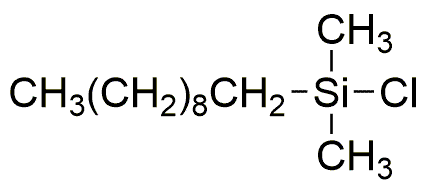Chloro-decyl-dimethylsilane is widely utilized in research focused on:
- Surface Modification: This compound is used to modify surfaces of materials, enhancing their hydrophobic properties. For example, it can be applied to glass or metal surfaces to create water-repellent coatings, which are beneficial in electronics and automotive industries.
- Adhesive Formulations: It serves as a coupling agent in adhesive formulations, improving adhesion between dissimilar materials. This is particularly useful in the construction and automotive sectors, where strong, durable bonds are essential.
- Biomedical Applications: In biomedical research, it can be employed to functionalize biomaterials, promoting better cell attachment and growth. This application is crucial in developing implants and tissue engineering scaffolds.
- Nanotechnology: The compound is used in the synthesis of silica nanoparticles, which have applications in drug delivery systems and diagnostics, offering targeted therapy options in medicine.
- Textile Treatments: It is also applied in the textile industry to impart water and stain resistance to fabrics, enhancing their durability and performance in everyday use.
General Information
Properties
Safety and Regulations
Applications
Chloro-decyl-dimethylsilane is widely utilized in research focused on:
- Surface Modification: This compound is used to modify surfaces of materials, enhancing their hydrophobic properties. For example, it can be applied to glass or metal surfaces to create water-repellent coatings, which are beneficial in electronics and automotive industries.
- Adhesive Formulations: It serves as a coupling agent in adhesive formulations, improving adhesion between dissimilar materials. This is particularly useful in the construction and automotive sectors, where strong, durable bonds are essential.
- Biomedical Applications: In biomedical research, it can be employed to functionalize biomaterials, promoting better cell attachment and growth. This application is crucial in developing implants and tissue engineering scaffolds.
- Nanotechnology: The compound is used in the synthesis of silica nanoparticles, which have applications in drug delivery systems and diagnostics, offering targeted therapy options in medicine.
- Textile Treatments: It is also applied in the textile industry to impart water and stain resistance to fabrics, enhancing their durability and performance in everyday use.
Documents
Safety Data Sheets (SDS)
The SDS provides comprehensive safety information on handling, storage, and disposal of the product.
Product Specification (PS)
The PS provides a comprehensive breakdown of the product’s properties, including chemical composition, physical state, purity, and storage requirements. It also details acceptable quality ranges and the product's intended applications.
Certificates of Analysis (COA)
Search for Certificates of Analysis (COA) by entering the products Lot Number. Lot and Batch Numbers can be found on a product’s label following the words ‘Lot’ or ‘Batch’.
Numéro de catalogue
Numéro de lot/série
Certificates Of Origin (COO)
This COO confirms the country where the product was manufactured, and also details the materials and components used in it and whether it is derived from natural, synthetic, or other specific sources. This certificate may be required for customs, trade, and regulatory compliance.
Numéro de catalogue
Numéro de lot/série
Safety Data Sheets (SDS)
The SDS provides comprehensive safety information on handling, storage, and disposal of the product.
DownloadProduct Specification (PS)
The PS provides a comprehensive breakdown of the product’s properties, including chemical composition, physical state, purity, and storage requirements. It also details acceptable quality ranges and the product's intended applications.
DownloadCertificates of Analysis (COA)
Search for Certificates of Analysis (COA) by entering the products Lot Number. Lot and Batch Numbers can be found on a product’s label following the words ‘Lot’ or ‘Batch’.
Numéro de catalogue
Numéro de lot/série
Certificates Of Origin (COO)
This COO confirms the country where the product was manufactured, and also details the materials and components used in it and whether it is derived from natural, synthetic, or other specific sources. This certificate may be required for customs, trade, and regulatory compliance.

